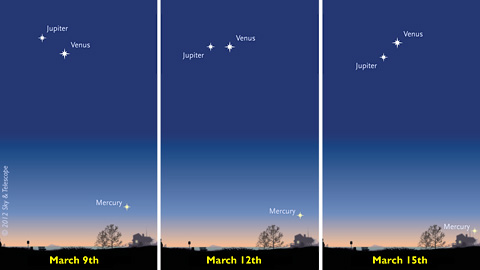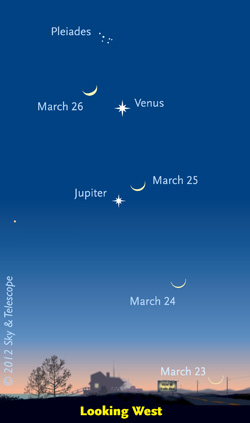March 7, 2012
Contact:
Alan M. MacRobert, Senior Editor
855-638-5388 x2151, [email protected]
Note to Editors/Producers: This release is accompanied by publication-quality graphics; see details at end.
For the past month the two brightest planets, Venus and Jupiter, have been an eye-catching duo in the western sky after sunset. Week by week they've been gradually sliding closer together, and their celestial performance is about to culminate.
By March 9th these dazzling evening "stars" are less than 5° apart, about the width of three fingers at arm's length. Then, from March 12th to 14th, the gap between them closes to just 3° as they pass one another in the evening sky. The pairing of these bright lights will be dramatic, though not especially rare.
Venus is the brighter one, for three reasons. First, it's close to the Sun, as planets go, basking in sunlight twice as bright as we receive on Earth and about 50 times more intense than the sunlight that reaches distant Jupiter. Second, it's almost seven times closer to Earth. And, its cloudy atmosphere is slightly whiter than Jupiter's, reflecting a little more of the sunlight that strikes it. These advantages combine to make Venus appear seven times brighter than Jupiter just now.
However, Jupiter is the far larger planet, and despite being 522 million miles away (versus 76 million for Venus) right now, it appears about twice as wide as Venus through a backyard telescope.
After March 14th, Jupiter continues to slide down closer to the Sun. By mid-April it will be too low to see after sunset, lost in the bright twilight. Venus, however, appears to edge a bit higher each night. It shines well over 40° above the horizon at sunset for most of the U.S. — about as high in the evening sky as it can get — and lingers in the sky after sunset for 4 hours through mid-April.
This month's celestial show has a second act! Two weeks later, the crescent Moon enters the western sky after sunset, adding to the spectacle. The delicately thin crescent appears close to Jupiter at nightfall on March 25th (especially so for eastern North America). The next night the Moon the will be higher, paired now with Venus.
Sky Publishing (a New Track Media company) was founded in 1941 by Charles A. Federer Jr. and Helen Spence Federer, the original editors of Sky & Telescope magazine. In addition to Sky & Telescope and SkyandTelescope.com, the company publishes two annuals (Beautiful Universe and SkyWatch), as well as books, star atlases, posters, prints, globes, and other fine astronomy products.
Sky & Telescope is making the following photographs and illustrations available to the news media. Permission is granted for one-time, nonexclusive use in print and broadcast media, as long as appropriate credits (as noted in each caption) are included. Web publication must include a link to SkyandTelescope.com.
 Venus and Jupiter form a spectacular pairing in the evening sky during mid-March. These scenes show the sky's appearance looking west about an hour after sunset. A third planet, Mercury, can be glimpsed just above the western horizon. Click here for a larger version with labels and here for a version without labels. Sky & Telescope diagram |
 Here is the scene looking west about an hour after sunset in late March. Over four evenings, a waxing crescent Moon will move upward past Jupiter and Venus. Click on the image for a high-resolution version. Sky & Telescope diagram |
 0
0
Comments
You must be logged in to post a comment.